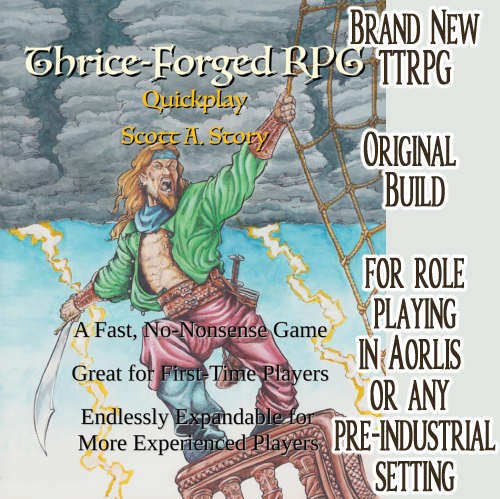Weapons & Steel
The Bones of War!
Steel is the bones of war, and deserves a mention here. The technology has kept pace here with the thirteenth century, so there is no cast iron yet, and mills aren’t able to produce large, homogeneous sheets yet. As a result, full plate armor is not yet possible, but coats of plate and lamellar are available. For weapon manufacture, and for forging weapons, crucible steel is quite rare.
There are two subclasses, Burlami Steel and Alusian Steel. Metal refiners and warriors argue about which is superior, and no consensus has ever been reached.
Burlami smiths are famous for their art, and they create high-level pattern welded (or wattled) steel. Sometimes called blue steel for its blue gleam, this metal is as good as modern, high-grade steel, and is famed for being very flexible, durable, and capable of holding a fine edge through much punishment.
This steel owes part of its reputation to the weapon's peerless geometry, as well as their amazing fittings and finish. The ore is mined at a series of mines in Wattenby Forest.
Alusian steel, also called black steel for its ebon glints, is also of superior quality, equivalent to Burlami steel and modern, high-grade mono steel. It only is mined from a series of iron-sand banks in the Skyline Mountains in Yrdath, Alusia. It is crucible steel, and is noted for keen edges and resistance to rust and corrosion.
The differences and comparative advantages of each steel, Burlami and Alusian, are academic. Either steel is in a class high above all the steel manufactures in and around Aorlis.
Both Alusian and Burlami steel are light, flexible, durable, and hold an edge well, and fighters from other countries admire these weapons.
Legendary weapons (especially swords) often were created by legendary smiths, and these are easy to identify because each smith stamped his mark into the blade. These craftsmen were all potent wizards and metalworkers, or blade-mages, so their maker’s marks are each magik sigils. Good provenance multiplies a great blade’s value exponentially, and these objects are collected jealously. Indeed, it is common for the works of these men (and two women) to find homes in the personal armories of great kings or heroes. Here are their maker’s marks.
12th century, Sciomancer who alloyed Alusian steel with shadowsmelt, Alusia
12th century, Burlam
13th century, modern Burlam
10th century, Burlam
10th century woman in Alusia
13th century, woman working in Fenwidden, Alusia
11th century, Burlam
8th century Alusia
Armor usually comes from a workshop, not an individual, and is a more cooperative process to source, form, and assemble. The most famous such is the Royal Gwyfnedi Arms Workshop in Gwyfned City, and it is known for the famed Gwyfnedi Mail.
In the 13th century, armor is in a transitional period, and the technological advances that will make large, homogenous plates needed for the full plate armor of later eras have not yet been invented.
Armor reinforced to withstand intense missile fire is called armor of “proof.” While this makes the armor very tough to breach, it also makes it heavier, hotter, and more cumbersome.
The most common armor is stuffed linen or padded, and its use is ubiquitous across all ranks of society.
Maille is still the king of armor, and it is worn over padded armor for maximum protection.
Reinforcing the maille with gorgets, coats of plate, lamelar, and splints have become more popular. These armors aren’t used independently, but as reinforcement for maille over padding.
Gunpowder is in its martial infancy in Aorlis, and it has not yet become a decisive factor on the battlefield. It has enjoyed success in siege warfare, in contrast. All the huge gonnes, mortars, and bombards are decorated and given impressive names, such as the Fire Wolf, of the Tongue of Doom.
For traditional siege engines, most notably giant trebuchets and rams, they also are named. Wall Eater, War Wolf, and Foul Neighbor are noteworthy.
While the subject of magikal weapons will be covered in depth elsewhere, there are certain notes to be considered here.
Any weapon can be enchanted, but the expensive/rare ones are much more likely to be enchanted.
Often, a spirit, egregore, or bound demon can be attached to a weapon, making the object seem sentient. Intent can also be injected into a weapon, but that is a simpler thing that does not behave intelligently.
The most common spells imbued in a weapon are:
Keen, Sharpness, Epic Sharpness, or Vorpal
Durability, Epic Durability, or Indestructable
Resist rust and corrosion
Fleetness
Singing
Accuracy
There are many magical effects, and curses, that can come with weapons, but those will be addressed under “Magic.”
























Comments